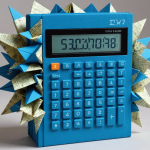
At the core of TensorFlow’s functionality lies the idea of computation graphs. These graphs serve as a blueprint for how data flows through the various operations defined in a model. Each node in the graph represents a mathematical operation, while the edges signify the tensors that flow between these operations. Understanding how to construct and manipulate these computation graphs very important for using TensorFlow’s full potential, especially for debugging and optimizing models.
In TensorFlow, the computation graph is constructed in a declarative manner. This means that instead of executing operations immediately, you define a series of operations and their dependencies first. Once the graph is defined, you can execute it in a session, feeding in the data as required.
Here’s a simple example of creating a computation graph in TensorFlow:
import tensorflow as tf
# Define the computation graph
a = tf.constant(5, name='a')
b = tf.constant(3, name='b')
c = tf.add(a, b, name='add')
# Create a session to run the graph
with tf.Session() as sess:
result = sess.run(c)
print("The result of adding a and b is:", result)
In this example, we create two constants, `a` and `b`, and then define a node `c` that performs the addition of these two constants. The `tf.Session()` is then used to execute the graph, and the `sess.run(c)` method evaluates the node `c`, returning the result of the addition.
TensorFlow also allows for more complex graphs involving variables, placeholders, and operations such as matrix multiplication or convolution. By structuring your computations graphically, TensorFlow efficiently manages resources and optimizes execution. Understanding the flow of data through these graphs not only aids in model building but also facilitates troubleshooting when things don’t work as expected.
As you progress, you’ll likely encounter more intricate graphs, including those that involve branching, loops, and other control flow constructs. All these features enable powerful abstractions that can be utilized to create sophisticated machine learning models.
Mastering computation graphs is essential for effective TensorFlow programming. By grasping how to design and manipulate these graphs, you can take full advantage of TensorFlow’s capabilities to create efficient, optimized models that are both flexible and powerful.
Setting Up TensorBoard for Visualization
To leverage TensorBoard for visualizing your computation graphs and monitoring model training, setting it up correctly is the first step. TensorBoard is a powerful tool that provides a suite of visualizations to help you understand your model’s architecture and the training process. To get started, ensure you have TensorFlow installed, as TensorBoard is included in the TensorFlow package.
Once you’ve confirmed TensorFlow is ready, the next task is to create a directory where TensorBoard can store its logs. That’s done within your training script, where you will also define a `FileWriter` to log the computational graph and any metrics you want to visualize. Let’s walk through a simple example of how to set this up.
import tensorflow as tf
# Create a simple computation graph as before
a = tf.constant(5, name='a')
b = tf.constant(3, name='b')
c = tf.add(a, b, name='add')
# Create a FileWriter to log the graph
log_dir = "logs/"
writer = tf.summary.create_file_writer(log_dir)
# Use the writer to log the graph
with writer.as_default():
tf.summary.trace_on(graph=True)
# Create a session to run the graph
with tf.Session() as sess:
result = sess.run(c)
print("The result of adding a and b is:", result)
tf.summary.trace_export(name="my_graph", step=0) # Export the graph
writer.close()
In this snippet, we not only define our computation graph but also set up a `FileWriter` that points to a directory named “logs/”. The `tf.summary.trace_on(graph=True)` function is called to start recording the operations in the graph, and after running the session, we use `tf.summary.trace_export()` to save the graph’s trace for TensorBoard to visualize.
To launch TensorBoard and view the logs, open your command line and run the following command:
tensorboard --logdir=logs/
After executing this command, you can navigate to http://localhost:6006 in your web browser to access the TensorBoard interface. Here you will find visualizations of your computation graph along with any other metrics you have chosen to log during your training process.
This setup not only provides a clear view of your model architecture but also allows you to monitor the training metrics like loss and accuracy, which can be invaluable for diagnosing issues and understanding your model’s performance. As you build more complex models, the ability to visualize the computation graph becomes increasingly critical, enabling you to make informed decisions about model adjustments and optimizations.
It’s worth noting that while TensorBoard is powerful in its capabilities, the clarity of your graphs depends heavily on the structure of your computation. Keeping your graph modular and organized will enhance the insights you can gain from TensorBoard visualizations. Take the time to implement logging strategically throughout your training process, ensuring that you capture all relevant metrics that will aid in your model’s development.
Visualizing Training Metrics and Model Performance
With TensorBoard properly set up, you can begin to visualize the training metrics and model performance, crucial components for understanding how your model learns over time. TensorBoard provides a powerful interface for tracking various metrics such as loss, accuracy, and other custom metrics you may define during your training process. By using these visualizations, you can gain insights into model behavior, identify potential issues, and make informed adjustments to enhance performance.
To visualize training metrics, you need to log these metrics during each iteration of training. This involves creating summary operations that record the values you want to track. Let’s ponder a simple example where we will log the training loss and accuracy for a model. In this case, we will be using the `tf.summary.scalar` function to log the values.
import tensorflow as tf
# Create a simple model
model = tf.keras.Sequential([
tf.keras.layers.Dense(10, activation='relu', input_shape=(1,)),
tf.keras.layers.Dense(1)
])
# Compile the model
model.compile(optimizer='adam', loss='mean_squared_error', metrics=['accuracy'])
# Create a FileWriter for logging
log_dir = "logs/"
writer = tf.summary.create_file_writer(log_dir)
# Dummy data for training
import numpy as np
x_train = np.random.rand(100, 1)
y_train = x_train * 2 + 1
# Training loop
for epoch in range(100):
# Train the model for one epoch
loss, accuracy = model.train_on_batch(x_train, y_train)
# Log the loss and accuracy
with writer.as_default():
tf.summary.scalar('Loss', loss, step=epoch)
tf.summary.scalar('Accuracy', accuracy, step=epoch)
writer.close()
In this example, we define a simple neural network model using Keras and compile it with an optimizer and loss function. During the training loop, we call `model.train_on_batch`, which returns the loss and accuracy for that batch. We then log both of these metrics using `tf.summary.scalar`, associating them with the current epoch number as the step.
Once the training is complete, you can launch TensorBoard to visualize these metrics. This will give you a clear view of how the loss and accuracy evolve over epochs. In your command line, use:
tensorboard --logdir=logs/
Upon navigating to http://localhost:6006 in your web browser, you will see graphs representing the loss and accuracy over time. The visualizations allow you to observe trends and fluctuations, helping you to determine if your model is converging, overfitting, or underfitting.
Furthermore, TensorBoard supports advanced visualizations such as histograms and distributions, which can be useful for monitoring the distribution of weights and biases in your model. This can be done using `tf.summary.histogram` for tracking the distribution of a tensor over time:
# Log the weights of the first layer
with writer.as_default():
tf.summary.histogram('Weights Layer 1', model.layers[0].weights[0], step=epoch)
By logging these additional metrics, you can gain deeper insights into how your model learns and adapts over time. The ability to visualize training metrics and model performance in TensorBoard is not just about tracking progress; it’s about enabling a feedback loop that informs your decisions as you refine your model.
Using TensorBoard effectively can transform your understanding of the model training process, allowing for a data-driven approach to model optimization. Whether you’re debugging, experimenting with different architectures, or fine-tuning hyperparameters, these visualizations provide the clarity needed to make informed choices that lead to improved model performance.
Debugging and Analyzing Computation Graphs with TensorBoard
Debugging and analyzing computation graphs is a pivotal part of working with TensorFlow, especially as your models become more intricate. TensorBoard serves as an indispensable ally in this regard, providing a visual interface to explore and understand the computation graphs you’ve built. When things go awry—whether it’s an unexpected output, a model that won’t converge, or performance issues—being able to visualize the graph can lead you to the root of the problem much faster than sifting through lines of code.
One of the primary features of TensorBoard for debugging is its ability to display the computation graph as a series of nodes and edges. Each node represents an operation, while the edges demonstrate how data flows between these operations. This visual representation allows you to see the overall structure of your model, making it easier to spot issues like missing connections or incorrect operation types.
To leverage TensorBoard for debugging, you need to ensure that your computation graph is being logged appropriately. Here’s how you can log a more complex graph that includes variables and operations:
import tensorflow as tf
# Define a more complex computation graph
x = tf.Variable(tf.random.normal([2, 2]), name='x')
y = tf.Variable(tf.random.normal([2, 2]), name='y')
z = tf.matmul(x, y, name='matrix_multiply')
# Create a FileWriter to log the graph
log_dir = "logs/"
writer = tf.summary.create_file_writer(log_dir)
# Use the writer to log the graph
with writer.as_default():
tf.summary.trace_on(graph=True)
# Create a session to run the graph
with tf.Session() as sess:
sess.run(tf.global_variables_initializer())
result = sess.run(z)
print("The result of the matrix multiplication is:", result)
tf.summary.trace_export(name="complex_graph", step=0) # Export the graph
writer.close()
In this example, we define a computation graph that includes two variables and a matrix multiplication operation. By using `tf.summary.trace_on(graph=True)`, we can capture the graph structure in our logs. After running the session, we call `tf.summary.trace_export()` to save the trace, which can later be viewed in TensorBoard.
Once you’ve logged your graph, you can open TensorBoard and navigate to the graph visualization section. This will allow you to explore the nodes, view the shapes of tensors at each stage, and inspect the operations in detail. If you notice that a tensor is not the shape you expected, you can investigate further to find where things might have gone wrong.
Another useful feature of TensorBoard for debugging is the ability to visualize the distribution of tensor values over time. By employing `tf.summary.histogram`, you can log the distribution of weights or intermediate activations, providing insights into how the values evolve during training:
# Log the intermediate outputs
with writer.as_default():
tf.summary.histogram('Output of z', z, step=epoch)
This allows you to monitor how the outputs change and can reveal problems such as saturation or vanishing gradients, which may indicate that your model is not learning effectively. Such insights are invaluable for diagnosing issues and adjusting hyperparameters or architectures accordingly.
Furthermore, TensorBoard’s profiling capabilities can help you identify performance bottlenecks in your computation graph. By profiling your model, you can get a detailed report on the time taken by each operation, which can guide optimizations. That’s particularly important when working with large datasets or complex models where performance can significantly impact training times.
Using TensorBoard for debugging and analyzing computation graphs enhances your ability to understand and troubleshoot your models. The visual feedback it provides is not just a way to confirm that your graph is correct, but a powerful tool for iteratively refining and improving your models based on empirical observations. As you become more adept at interpreting the visualizations, you will find that debugging becomes a more intuitive and efficient process, ultimately leading to more robust and effective machine learning solutions.






